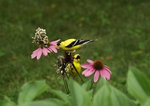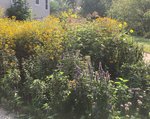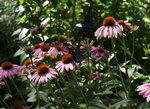




Despite the roller-coaster temperatures and freeze-thaw hazards in Minneapolis this month, after all it is March and the familiar flowers of spring will soon emerge. But as many people anticipate and celebrate the familiar blooms of crocuses, hyacinths, tulips, daffodils, irises and lilacs, a growing gardening movement shows that these strictly ornamental plants, however beautiful, contribute nothing to our environment and are actually a desert for birds and other wildlife.
Conventional landscaping techniques that further colonize and diminish the landscape with non-native species of trees and other plants are degrading and reducing habitat for pollinators and birds. Native plant gardening can restore the ecosystems of our own yards and in the process create habitat for pollinators, birds and other wildlife. Why should gardeners care, and begin to see their yards as habitat? Because as habitat declines, populations of insects and birds are rapidly declining, with ultimately dire consequences for our own species, too. The current decline in biodiversity is threatening not only birds and wildlife, but humans and our own ability to maintain our quality of life, and even to survive.
North America has lost more than 3 billion birds over the past 50 years, an “astounding result” even to researchers. Since 1970, more than one in four birds have disappeared from the landscape. Declines were far-reaching across many species, including common backyard birds. Substantial declines in insect populations throughout the world are contributing to the loss of birds, since 96 percent of birds feed insects to their young.
Simply put, native plants are those species that occur naturally in a region in which they evolved. Non-native species include trees and plants from other regions or continents, as well as cultivars including “nativars” that are bred to alter specific characteristics to suit human criteria, such as aesthetics or disease resistance.
Native plants developed over thousands of years and are adapted to local weather, local soil and to the other plants and animals indigenous to the area in which they evolved. Most importantly, native plants provide food for wildlife, including insects, birds and other species. Having evolved with native wildlife, native plants are the ecological basis upon which life depends for all animals, including people.
With so much habitat lost and many native plants replaced with exotic plants, some wildlife species have become endangered and their chance of survival depends on us. By creating bird-friendly gardens and landscapes with native plants, people can provide habitat and help sustain biodiversity in our neighborhoods.
Simple actions to restore the ecology of our own yards and green spaces in our community include reducing or eliminating lawns, eradicating invasive species, and planting keystone species of native plants, including trees, shrubs, grasses, sedges and flowers. Both the National Audubon Society and National Wildlife Federation offer databases to search for plants native to our region. A free booklet from the Saint Paul Audubon Society is also available online.
Humans enjoy many positive effects when we prioritize native species in our yards. Native plants are just as beautiful as non-native plants, and less work to maintain. Once established, they seldom need watering, mulching or protection from the weather. The deep roots of many native plants can help prevent erosion and manage stormwater by infiltrating rain that might otherwise drain into streets and pollute our lakes and rivers.
Native plants are healthier for people because artificial fertilizers, pesticides and herbicides are not necessary. Landscaping with native plants can also help address climate change, as research shows that native trees and shrubs sequester carbon in a more stable manner than exotic ones. By providing wildlife with essential foods (including nectar, caterpillars, nuts, seeds, and fruits), native plants support the life cycles of pollinators, birds and other wildlife, which increase humans’ experience and enjoyment of Nature around us.
Constance Pepin is co-chair of the Audubon Chapter of Minneapolis Advocacy Committee, co-founder of Friends of Roberts Bird Sanctuary, and co-leader of the Linden Hills Naturescape project.
Comments
No comments on this item Please log in to comment by clicking here